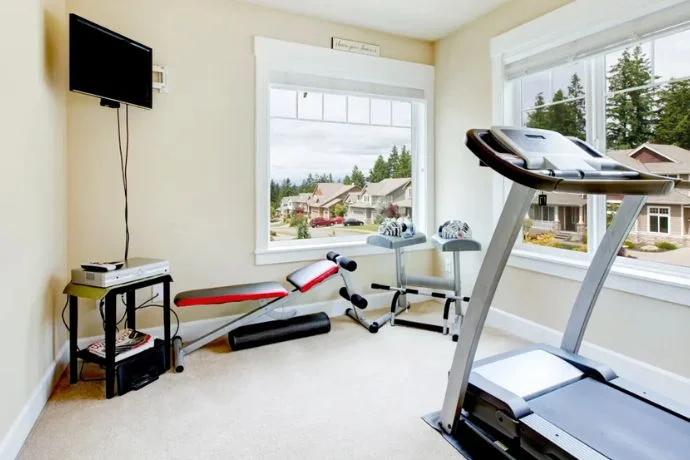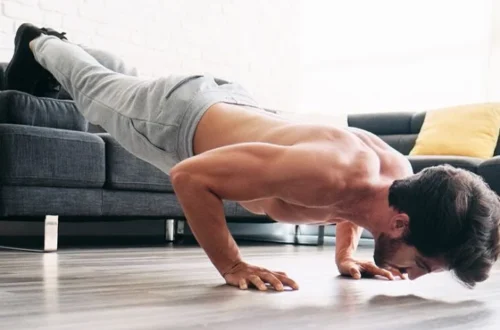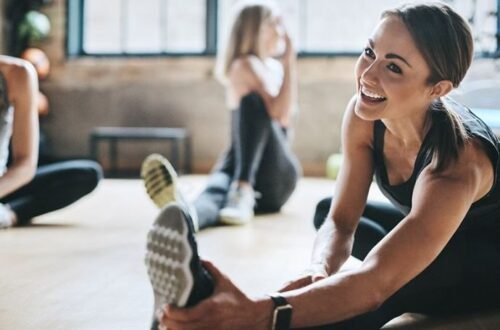When I decided to buy my own home gym setup equipment, it was one of the best things I’ve done for my health. I used to spend $80 a month for a gym membership that I hardly ever used. I would make up any reason not to work out, such as how long it took to travel to the gym, how long I had to wait for equipment, or how terrified I was of other people at the gym.
You don’t need a lot of money or a big house to construct a nice training space at home. My whole setup fits in a 10×10-foot piece of my garage and costs less than two years’ worth of gym membership fees. More importantly, it has given me results and consistency that I could never receive at a commercial gym.
If you don’t like crowded gyms, paying monthly fees, or having difficulties finding time to go to the gym, this piece is for you. I’ll show you how to set up your own home gym, tell you which pieces of equipment are the best value for your money, and give you tips on how to make your training space work for you, no matter how much money or room you have.
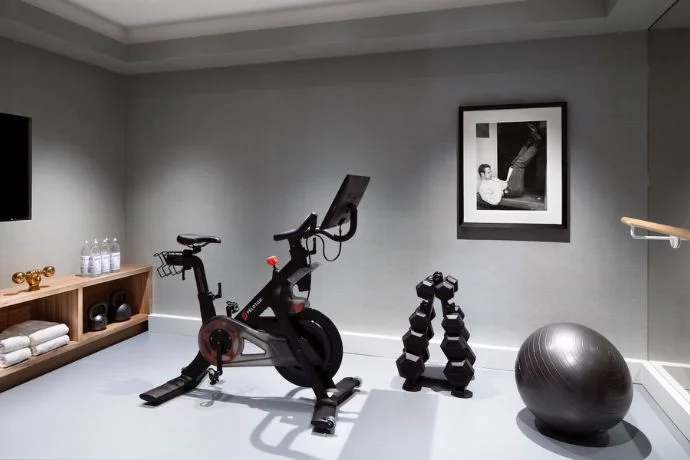
Why I Made the Switch to a Home Gym
To be honest, I wasn’t sure if I could work out at home at first. I thought I needed fancy machines and a group of people to keep me going. But after six months of going to the gym only sporadically and spending money, I felt I had to do something.
The Breaking Point
It was a dark Tuesday night when I hit my limit in the gym. I drove 15 minutes to the gym after a long day at work, but the equipment I needed was already being used. I waited another 20 minutes, did a fast workout that wasn’t very good, and then drove home mad. I spent more time getting to and from the gym and waiting than I did working out.
That night, I worked out how much my gym membership truly cost: $80 a month, plus gas, parking, and most importantly, the time it took. Every month, I spent about $150 on workouts that were hard to stick with and made me mad.
The Home Gym Advantages
The way I’ve set up my home gym has given me perks I never thought possible:
Convenience: Since I don’t have to drive to work, I can fit in workouts between meetings or first thing in the morning. A 30-minute workout truly only takes 30 minutes, not 90, when you factor in travel time.
Consistency: I worked out more often after getting rid of obstacles. I went from 2–3 times a week to 5–6 times a week. The tools are always available when I need them.
Privacy: You won’t have to wait, no one will judge you, and you won’t feel bad about trying new things. I can grunt, sweat, and mess up new moves without anyone seeing me.
Long-term savings: My first investment of $1,200 has already paid for itself, and it will keep saving me money for a long time.
Customization: Every piece of equipment is helpful for my own demands and wants. There isn’t any additional space on PCs that I won’t use.
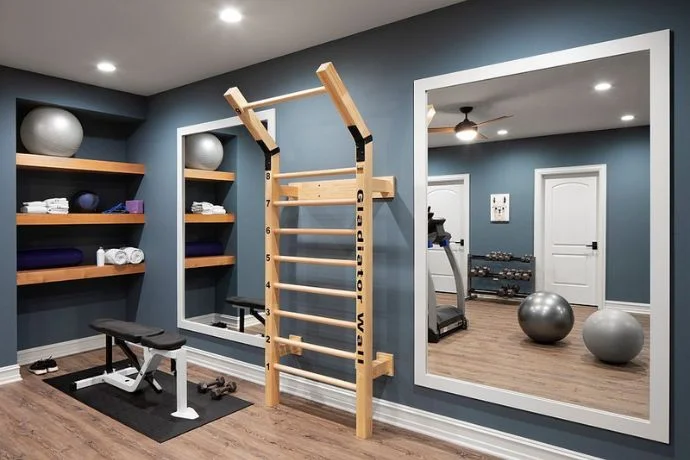
My Complete Home Gym Setup: Equipment and Layout
My workout space ideas evolved over two years of trial and error. Here’s my current setup and why each piece earned its place:
The Foundation: Essential Equipment
Power Rack with Pull-up Bar ($400)
This is the most significant aspect of my home workout space. You can do a lot of safe exercises with a proper power rack, such as squats, bench presses, pull-ups, and more. The safety bars enable me to lift heavy weights by myself, without a spotter.
I chose a simple yet strong model that had:
- Squats and bench press have adjustable safety rails.
- Different ways to hold the pull-up bar
- Plate storage pegs to help you keep your weights in order
- Small footprint that fits in most places
Olympic Barbell and Weight Plates ($300)
A decent Olympic barbell can handle all of the large compound exercises, such as squats, deadlifts, bench presses, rows, and overhead presses. I started with 300 pounds of weight plates, which is enough for most strength training.
Buying tip: You can find secondhand tools on Facebook Marketplace or Craigslist. I found plates that had only been used a few times for $1 a pound instead of the normal $2 to $3 per pound.
Adjustable Bench ($200)
You can do flat, incline, and decline presses on an adjustable bench. It also helps with several other workouts, such as step-ups, single-arm rows, and more.
Key features to look for:
- Strong construction that won’t shake when big things are on it
- Simple way to make changes
- Soft cushioning that won’t get smaller over time
Power Tools: Maximum Impact Equipment
Adjustable Dumbbells ($300)
The barbell can handle heavy complex movements, while adjustable dumbbells are more versatile and may be utilized for single exercises, unilateral training, and quick circuit workouts.
I have PowerBlocks that enable me to alter the weight of each dumbbell from 5 to 90 pounds. They are tiny, quick to switch out, and you don’t need more than one set of fixed-weight dumbbells.
Kettlebells: 20, 35, and 53 pounds ($150)
Kettlebells gave people a whole new way to work out. They are great for:
- Training using high-intensity intervals
- Patterns of functional movement
- Workouts for metabolic conditioning
- Strength and aerobic workouts together
Three weights address most needs: light for high-rep conditioning, medium for moderate strength exercises, and heavy for significant strength building.
Resistance Bands Set ($40)
Don’t think bands aren’t strong. They may be used in many different ways, don’t take up much room, and offer different levels of resistance that work well with free weights.
I use them for:
- Exercises to warm up and get going
- Help with dips and pull-ups
- Adding weight to bodyweight exercises
- Work on rehabilitation and mobility
The Support System: Comfort and Safety
Rubber Floor Mats ($100)
Proper flooring protects your equipment, reduces noise, and provides cushioning. I used interlocking rubber mats made for gyms since they last a long time, are easy to clean, and absorb shock quite well.
Mirrors ($80)
Mirrors on the wall aren’t just for looks; they’re also for safety. You need to adopt the appropriate technique to avoid being hurt and get the most out of your workout. When you work out alone, mirrors might help you keep an eye on your form.
Sound System ($60)
You might have more fun and do better at the gym if you listen to good music as you work out. I set up Bluetooth speakers that connect to my phone so I can listen to happy music.
Storage and Organization
Weight Storage Rack ($100)
Putting your equipment in order makes workouts safer and more effective. A weight rack keeps plates in order and makes them easy to get to.
Accessory Storage ($50)
Hooks, shelves, and bins keep smaller items organized:
- Resistance bands
- Jump ropes
- Exercise balls
- Foam rollers
- Towels and water bottles
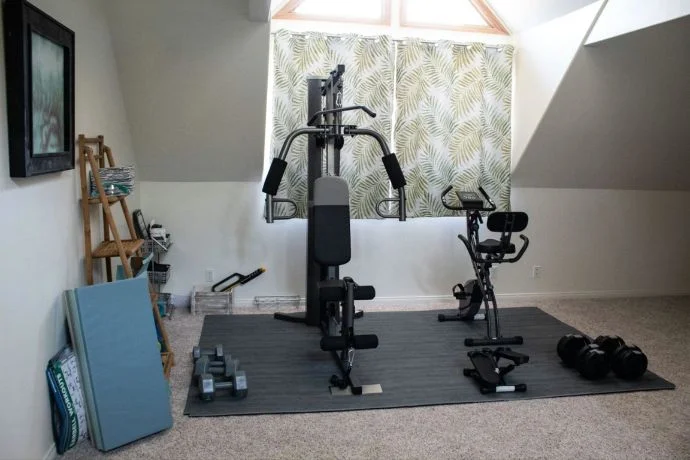
Budget-Friendly Home Gym Setup Options
Not everyone can put down $1,200 right away. Here are some ways to set up a gym that won’t break the bank, depending on your budget:
The Starter Setup: Under $300
Essential equipment:
- Adjustable dumbbells ($150)
- Resistance bands set ($40)
- Exercise mat ($30)
- Jump rope ($20)
- Suspension trainer ($60)
With this setup, you can focus on your strength, cardio, and flexibility all over your body. You can do hundreds of exercises and obtain great results while working towards a more complete setup.
The Intermediate Setup: $300-600
Add to starter setup:
- Kettlebell set ($120)
- Pull-up bar ($50)
- Adjustable bench ($150)
- Additional resistance options ($80)
This configuration meets 90% of most people’s fitness needs and gives them a lot of room to improve.
The Advanced Setup: $600-1200
Complete the foundation:
- Power rack ($300)
- Olympic barbell and plates ($300)
- Upgrade dumbbells ($200)
- Professional accessories ($100)
This level gets close to what a commercial gym can do while still being convenient and affordable for home workouts.
Money-Saving Strategies
Buy used equipment: Fitness equipment is useful for a long time. I saved 40% to 50% by buying old equipment that was still in good shape instead of new equipment.
Build gradually: Start with the essentials and add more gear when you can afford it. This also helps you figure out what you really need and what just looks nice.
Multi-purpose equipment: Choose items that can be used for more than one thing instead of ones that can only be utilized for one thing.
DIY solutions: Whenever you can, make your own attachments, platforms, and storage solutions.
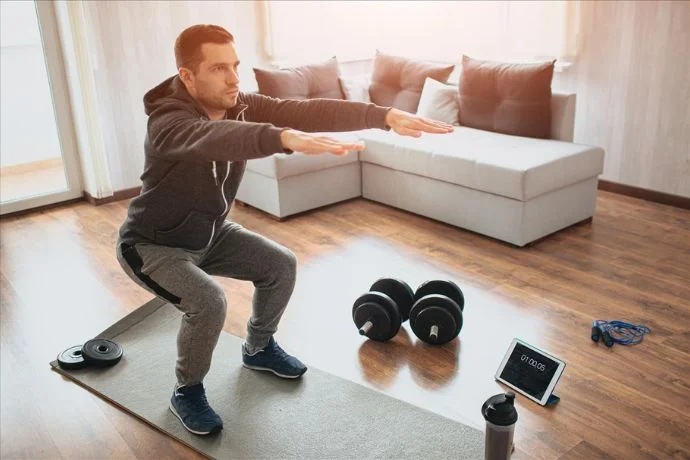
Workout Space Ideas for Any Living Situation
You don’t need a separate room to make a successful home gym. Here are some choices for different kinds of living situations:
Garage Gym Setup
Advantages:
- More space for tools
- Air flow is better
- Easy to keep everything in order
- Can hold tools that are bigger and heavier
Considerations:
- Keeping the temperature steady when it’s very hot or very chilly
- Concrete floors need some extra padding.
- Keeping tools dry for a long time
- Protecting costly tools
My garage solutions:
- Insulated walls and a fan to move air around more
- Rubber flooring over concrete
- Dehumidifier to stop rust
- Cameras for home security systems
Basement Home Gym
Advantages:
- Controlled climatic environment
- Calm and private
- Space that doesn’t get used too often
- Good for training all year long
Considerations:
- Restrictions on ceiling height
- Managing moisture
- Good light
- Air flow through the ventilation
Optimization tips:
- Check the height of the ceiling for movements above.
- Put up mirrors to make the room feel bigger.
- Use LED lights to make the lighting better.
- Use a dehumidifier to keep your equipment safe.
Living Room Setup
Advantages:
- No more room needed
- Controlled by the weather
- Easy to fit into your regular life
- Good air flow and light
Considerations:
- Storing equipment between workouts
- Things to think about for neighbours when it comes to noise
- Not enough room for bigger tools
- Keeping floors and furnishings safe
Space-saving solutions:
- Equipment that can be folded up and stored
- Suspension trainers and resistance bands
- Routines that focus on body weight
- Small tools that can do a lot of things
Apartment and Small Space Solutions
Advantages:
- Forces focus on the basics
- Less money needed up front
- Simple to keep up with and organise
- Encourages workouts that are fun
Equipment priorities:
- Resistance bands (don’t take up much room)
- Suspension trainers that attach to a door
- Adjustable dumbbells (replace the whole set of weights)
- Exercise mat that rolls up for easy storage
- Kettlebells are small and useful.
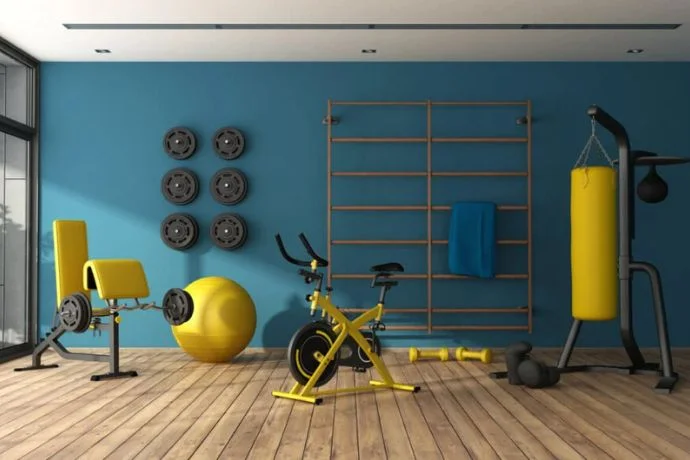
Setting Up Your Space for Success
How you set up your home training area could change how safe, motivated, and productive you are. This is how I made my space better:
Safety First
Adequate space: Make sure there’s enough space for all the exercises so you don’t strike the walls, ceiling, or equipment. I make sure there is at least three feet of space around me as I walk.
Proper flooring: Put money on the right flooring to keep your stuff safe and lower the chance of an accident. Rubber mats are worth the money because they are comfortable and stable.
Emergency planning: If you’re lifting large things, make sure you can get away from danger. Safety bars on the power rack are quite important if you work out by yourself.
Environmental Optimization
Lighting: Lighting that is good for you makes you look better, feel better, and be safer. I put LED strip lights in the room to get rid of shadows and make it feel more alive.
Temperature control: When you can work out for longer, it’s more fun when the weather is nice. I put in a fan to help the air move while I work out hard.
Ventilation: Fresh air keeps the room from feeling stuffy and helps you get better between sets.
Sound management: When you buy flooring and tools, keep your neighbors in mind. A lot of the noise that falling weights make went away when I put down rubber mats.
Psychological Setup
Dedicated space: Having a special spot to work out, even if it’s just a corner of a room, could help you get in the right mood.
Visual motivation: I hang mirrors, quotes that inspire me, and images of my accomplishments to keep myself going.
Organization: When your workout equipment is clean and organized, it makes working out more pleasurable and useful. Everything has its place.
Personalization: Make the area your own by using colors, music, and decorations that you like.
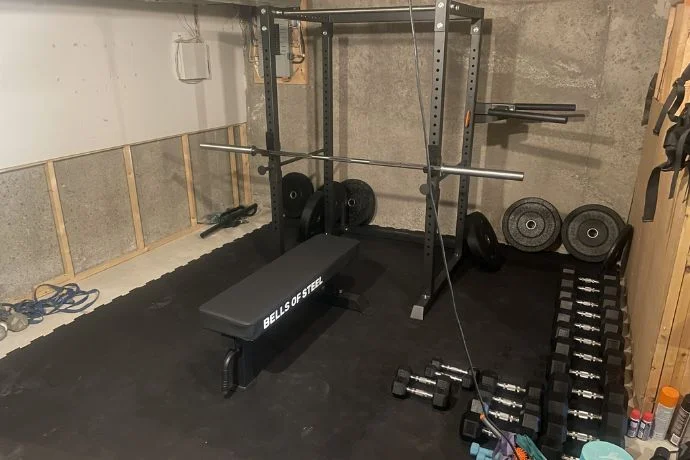
Essential Accessories That Make a Difference
In addition to the primary equipment, these additions make my home gym safer, more comfortable, and better at obtaining results.
Safety and Form
Weightlifting Belt ($40): Helps keep the core steady during heavy deadlifts and squats. Not necessary for serious strength training, but incredibly useful when lifting heavy weights alone.
Wrist Wraps ($20): When you press down forcefully, brace your wrists. This is really important for folks who have damaged their wrists before.
Lifting Straps ($15): These workouts assist you in preserving your grip while pulling hard when grip is the limiting factor.
Comfort and Convenience
Exercise Mat ($30): Important for core work, stretching, and working out on the floor. Choose one that is thick enough to be comfortable but not too thick to do balance exercises on.
Towels ($20): A few gym towels for cleaning equipment and for personal usage. Cleaning tools keep it clean and in good repair.
Water Bottle Station ($25): Having quick access to water keeps you hydrated without halting your workout.
Recovery and Mobility
Foam Roller ($30): An instrument for self-massage that helps muscles repair and keeps them from getting hurt. I use it before and after I work out.
Lacrosse Ball ($5): Targeted trigger point release for tight locations that foam rolling can’t get to very well.
Stretching Strap ($15): Helps in stretching and flexibility work, especially for tense hamstrings and shoulders.
Technology Integration
Bluetooth Speakers ($60): Good sound makes workouts more pleasurable, and music that gets you moving can help you do better.
Tablet Mount ($25): For watching training videos, keeping track of your workouts, or having fun as you work out.
Timer/Clock ($15): Seeing breaks and interval training times helps keep workouts organized and productive.
My Weekly Workout Routines
You need more than simply the right tools at home; you also need to establish good habits. Every week, I utilize these programs:
Strength-Focused Week
Monday – Upper Body:
- Bench press: 4 sets of 5 reps
- Bent-over rows: 4 sets of 8 reps
- Overhead press: 3 sets of 8 reps
- Pull-ups: 3 sets to failure
- Dumbbell accessories: 15 minutes
Wednesday – Lower Body:
- Squats: 4 sets of 5 reps
- Romanian deadlifts: 4 sets of 8 reps
- Bulgarian split squats: 3 sets of 10 each leg
- Leg accessories with bands: 15 minutes
Friday – Full Body:
- Deadlifts: 4 sets of 5 reps
- Push-ups: 3 sets of 15 reps
- Kettlebell swings: 4 sets of 20 reps
- Plank variations: 10 minutes
Conditioning-Focused Week
Tuesday/Thursday/Saturday – Circuit Training:
- 5-minute warm-up
- 20 minutes of rotating circuits using all equipment
- 5-minute cool-down and stretching
Circuits include:
- Kettlebell complexes
- Dumbbell circuits
- Bodyweight challenges
- Resistance band circuits
Hybrid Training Week
Strength and conditioning work together to help you get healthy in a way that is good for you. This is how I usually do things because it has a lot of good qualities about it.
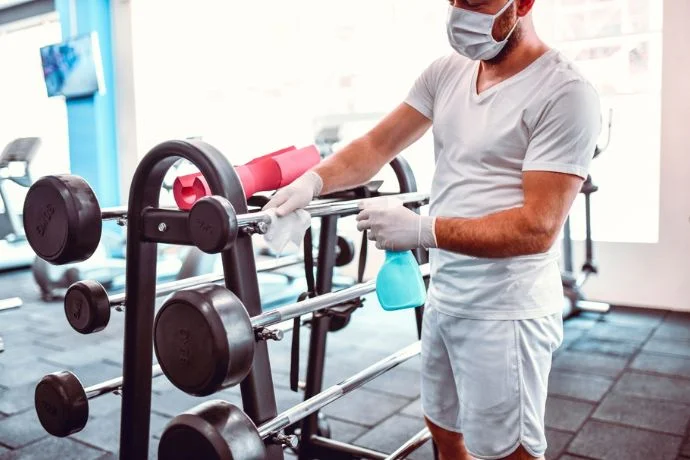
Maintaining Your Home Gym Equipment
Taking good care of equipment keeps it working longer and keeps people safe. This is how I look after things:
Daily Maintenance
Equipment cleaning: To protect bacteria from forming and your equipment from breaking down, wipe off all the surfaces you touched after each workout.
Visual inspection: Check for loose bolts, worn-out parts, or damage before every workout. For safety, fix problems straight away.
Organization: Return all of the tools to their proper places. This stops items from breaking and makes the next workout go more smoothly.
Weekly Maintenance
Deep cleaning: Cleaning all of the mats, equipment, and surfaces extremely well. Different types of materials need different sorts of cleaners.
Lubrication: Put oil on the moving parts of adjustable equipment to protect it from wearing out and working well.
Bolt tightening: Check that all the bolts and connections are tight. Home gyms get more use out of each piece of equipment than commercial gyms do.
Monthly Maintenance
Equipment rotation: To keep items from wearing out unevenly, change how you utilize them. For example, change the dumbbells you use often.
Preventive replacements: Get fresh cords, workout bands, and cushions before they break.
Environment control: Check and adjust the systems that control the temperature, humidity, and airflow.
Seasonal Maintenance
Deep inspection: A thorough check of all the equipment to see if it needs repairs, modifications, or new parts.
Rust prevention: Very important in places with a lot of moisture. Right away, clean and cure any patches of rust.
Equipment upgrades: Check out what works and what needs to be fixed or changed.
Troubleshooting Common Home Gym Challenges
There are issues with any room in your home for working out. Here are the most common problems I’ve fixed:
Challenge 1: Motivation Without Social Environment
Solution strategies:
- Video conversations with virtual workout partners
- Social media and online fitness groups
- Structured programmes that hold you accountable
- Setting goals and keeping track of progress
- Consistent reward systems
Challenge 2: Space Limitations
Solutions:
- Choosing tools that can do more than one thing
- Vertical storage options
- Options that can be folded and carried
- Integrating outdoor workouts
- Time-sharing plans with family members
Challenge 3: Noise Concerns
Solutions:
- Mats and floors made of rubber
- Working out at the right times
- Talking to your neighbours
- Choosing quieter equipment was a priority.
- Materials that reduce sound
Challenge 4: Temperature Control
Solutions:
- Changing the times of workouts based on the season
- Heating and cooling systems that are easy to move
- The right clothes for working out in different weather
- Rules for staying safe and hydrated in very hot or very cold weather
- Other places to get inside when the weather is bad

The ROI of Your Home Gym Investment
My budget-friendly gym setup delivers measurable returns beyond just financial savings:
Financial Returns
Direct savings:
- Gym membership: $960 annually
- Gas and parking: $300 annually
- Time value (3 hours weekly): $3,600 annually
- Total annual savings: $4,860
My setup cost: $1,200 initial investment
Payback period: 3 months
5-year savings: $23,100 (after initial investment)
Health and Productivity Returns
Quantifiable benefits:
- 150% increase in workout consistency
- 30% improvement in strength metrics
- Better sleep quality (tracked via fitness watch)
- Reduced stress and improved mood
- Higher energy levels throughout the day
Lifestyle Returns
Intangible benefits:
- Eliminated commute stress and time waste
- Increased flexibility in workout timing
- Privacy for trying new exercises
- Family involvement in fitness activities
- Greater long-term commitment to fitness
Your Home Gym Setup Action Plan
Ready to create your own effective home gym setup? Here’s your step-by-step guide:
Phase 1: Planning and Assessment (Week 1)
- Space evaluation: Measure available space and assess limitations
- Budget determination: Set a realistic budget based on the financial situation
- Goal clarification: Define specific fitness objectives and priorities
- Research phase: Compare equipment options and read reviews
- Timeline creation: Establish a realistic timeline for setup completion
Phase 2: Foundation Building (Weeks 2-4)
- Essential equipment purchase: Start with the highest-impact items
- Space preparation: Flooring, lighting, and environmental setup
- Safety installation: Mirrors, emergency procedures, and a first aid kit
- Organization systems: Storage solutions and equipment placement
- Initial routine development: Create starter workout programs
Phase 3: Optimization and Growth (Months 2-3)
- Equipment additions: Add pieces based on experience and needs
- Routine refinement: Adjust programs based on results and preferences
- Environment enhancement: Improve comfort, motivation, and functionality
- Maintenance establishment: Create sustainable upkeep routines
- Community building: Connect with other home gym enthusiasts
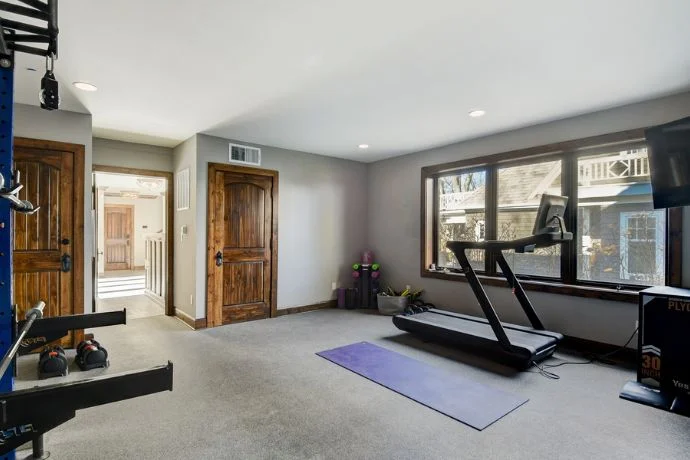
Start Building Your Home Gym Today
One of the best things I’ve done for my health is set up a solid home gym. It took away my excuses, made me more consistent, and helped me get better results than I ever did at commercial gyms. More importantly, it’s provided me a long-term, sustainable strategy to be healthy and fit that fits into my life.
Your home gym doesn’t have to be perfect right away. Start with the basics, see what works for you and your goals, and then add more as you need it. The most important thing is to begin. You will be glad you spent time and money on your health and fitness in the future.
Ready to transform your fitness with your own home gym setup?
- Assess your space and budget this week
- Choose your starter equipment based on your primary fitness goals
- Set up your dedicated workout area, even if it’s just a corner of a room
- Schedule your first workout for tomorrow morning
- Track your progress and adjust as you learn what works best
You might utilize the money you’re spending on a gym membership that you don’t use very often to start building your own gym at home. Every month you wait is another month of bad results and money wasted.
The perfect place for you to work out is ready to be made. The only thing left to do is figure out when you’ll start building it.

